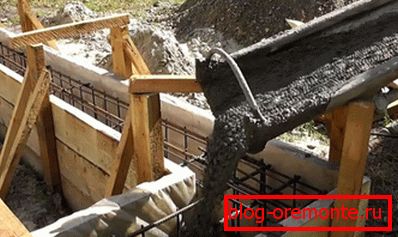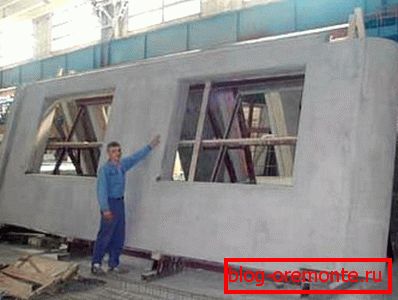Types of reinforced concrete structures: foundation,
The emergence of reinforced concrete structures in the nineteenth century was a real breakthrough in building technology. To date, without them it is impossible to imagine any construction object. In this article we will consider what concrete structures exist, and what characteristics they possess.

General information
What is reinforced concrete
Бетон, как известно, отличаются высокой прочностью на сжатие, однако, его сопротивление на растяжение не велико – в 10-15 раз меньше прочности на сжатие. Поэтому неармированные бетонные конструкции используются очень редко. Чтобы устранить этот недостаток, в его структуру добавляют стальную проволоку или прутья, отлично работающие на растяжения (читайте также статью «Асфальтобетонные смеси: основные разновидности, особенности приготовления и использования»).
Thus, reinforced concrete is a material formed by concrete and metal reinforcement located inside it. In aggregate, a single structure is obtained, which has high strength due to the combination of properties of concrete and metal.
For the first time, reinforced concrete products began to be patented at the end of the nineteenth century. More than 150 years have passed since then, and during this time, of course, reinforced concrete has seriously improved. However, it is safe to say that its “evolutionary” process is not yet complete.

Types of reinforcement
Nowadays, reinforced concrete structures are reinforced not only to increase the tensile strength of concrete, but also for off-center and axial compression, torsion, etc. In addition, the working reinforcement allows to reduce the size of the section of elements, as well as reduce the weight of structures.
Along with the usual reinforcement, today pre-stressed reinforced concrete structures are widespread. Their feature is that in the manufacture of concrete is subjected to compression, and the armature itself is pre-stretched.
Pre-stress can significantly increase the crack resistance, as well as reduce the deformation of structural elements. With prestressing, large-span reinforced concrete structures are usually performed, as well as other elements that are expected to carry a large tensile load.

Features of reinforced concrete structures
Virtues
Among the advantages of reinforced concrete structures are:
- Durability - thanks to the reliable preservation of reinforcement, which is under a layer of concrete, reinforced concrete has exceptional durability. In addition, the material copes with weathering.
- Strength - over time, the strength of reinforced concrete is not reduced, but even increases.
- The possibility of making their own hands, for example, during the construction of the foundation. To do this, you just need to make a formwork and make a metal frame of reinforcement, after which the formwork is filled with concrete solution.
- Fire resistance - reinforced concrete perfectly resists fire. Moreover, to increase the fire resistance, special aggregates are added to the composition, such as basalt, fireclay, blast furnace slag, etc. In addition, it is possible to increase the fire resistance by increasing the protective layer to 3-4 cm.
- Seismic resistance - Unlike other building materials, reinforced concrete, due to solidity, is well resisted by seismic activity.
- Good performance - reinforced concrete can take any architectural or constructive form.
- Given the strength and durability of the material, its price is quite affordable.
disadvantages
The disadvantages of reinforced concrete structures include the following points:
- Great weight;
- High heat and sound conductivity;
- Cracking tendency.
Tip! To insulate reinforced concrete, use heat-insulating materials such as polystyrene foam and mineral wool. The installation instructions for thermal insulation are quite simple.

Types of reinforced concrete structures
All existing reinforced concrete structures can be divided into three types:
| Prefabricated | Recently, they are very popular, as their use allows to maximize the mechanization of construction. In addition, the manufacture of concrete products in the factory allows the use of advanced technology solution preparation, as well as its installation and processing. |
| Monolithic | Used in the construction of structures that are not amenable to separation and unification. These include some hydraulic structures, heavy foundations, structures performed in sliding formwork, etc. |
| Prefabricated monolithic | As it is not difficult to guess, are a combination of monolithic concrete and prefabricated elements that are laid on the object. Embedded parts for reinforced concrete structures allow interconnecting prefabricated monolithic products not only with concrete, but also by welding metal elements. |
According to the scope of the design can be:
- for public buildings and residential buildings;
- for industrial buildings;
- for general purpose buildings.
Tip! Book Reinforced concrete structures of one-story industrial buildings - Zaikin A.I. It will allow you to get acquainted in detail with the features and performance of the calculation of foundations, columns, floor slabs and other reinforced concrete structures used in the construction of industrial structures.
As mentioned above, concrete products are also divided into:
- Prestressed;
- Unstressed.
The most common types of reinforced concrete structures
Now let's get acquainted with the most common types of reinforced concrete structures that are commonly used in construction.
These include:
- Foundationы;
- Panels;
- Beams and floor slabs;
Each of these elements has its own purpose and design features.

Foundation
Foundationы из железобетона устраивают под стены строений, колонны и столбы, а также под тяжелые станки и машины.
Foundations are of two types:
- National teams;
- Monolithic.
In addition, they differ in type of construction on:
- Belt - under the bearing walls;
- Step and pyramidal - under separate support.

Columns
Most often used in industrial buildings, in which floors are subjected to heavy loads from equipment. In this case, perform the frame, consisting of columns, beams and other elements.
In addition, prefabricated frame-panel prefabricated buildings in which the columns are one of the main supporting elements are widespread. They take on themselves the load and through the foundation pass them to the ground.

Panels
In the construction of frame-panel structures, for the manufacture of walls using panels. Their area can be up to 25 square meters.
It should also be noted that there are frameless panel buildings. In this case, the entire load is perceived by the walls and partitions, i.e. the panels themselves.

Slabs and beams
These designs are related to bending elements. Plates are called flat products, the length and width of which is significantly greater than the thickness. Beams are linear elements, the length of which is significantly larger than the transverse dimensions.
Slabs and beams are most often used for the device of flat floors and coatings. As mentioned above, they are usually pre-stressed. In addition, there are some other design features of reinforced concrete bent elements, which is associated with the area of their application.
Conclusion
Concrete and reinforced concrete structures are used in various areas of construction, so they are of different types. As an example, we gave only the most common types of structures. In fact, there are many more.
From the video in this article, you can get more information on this topic.